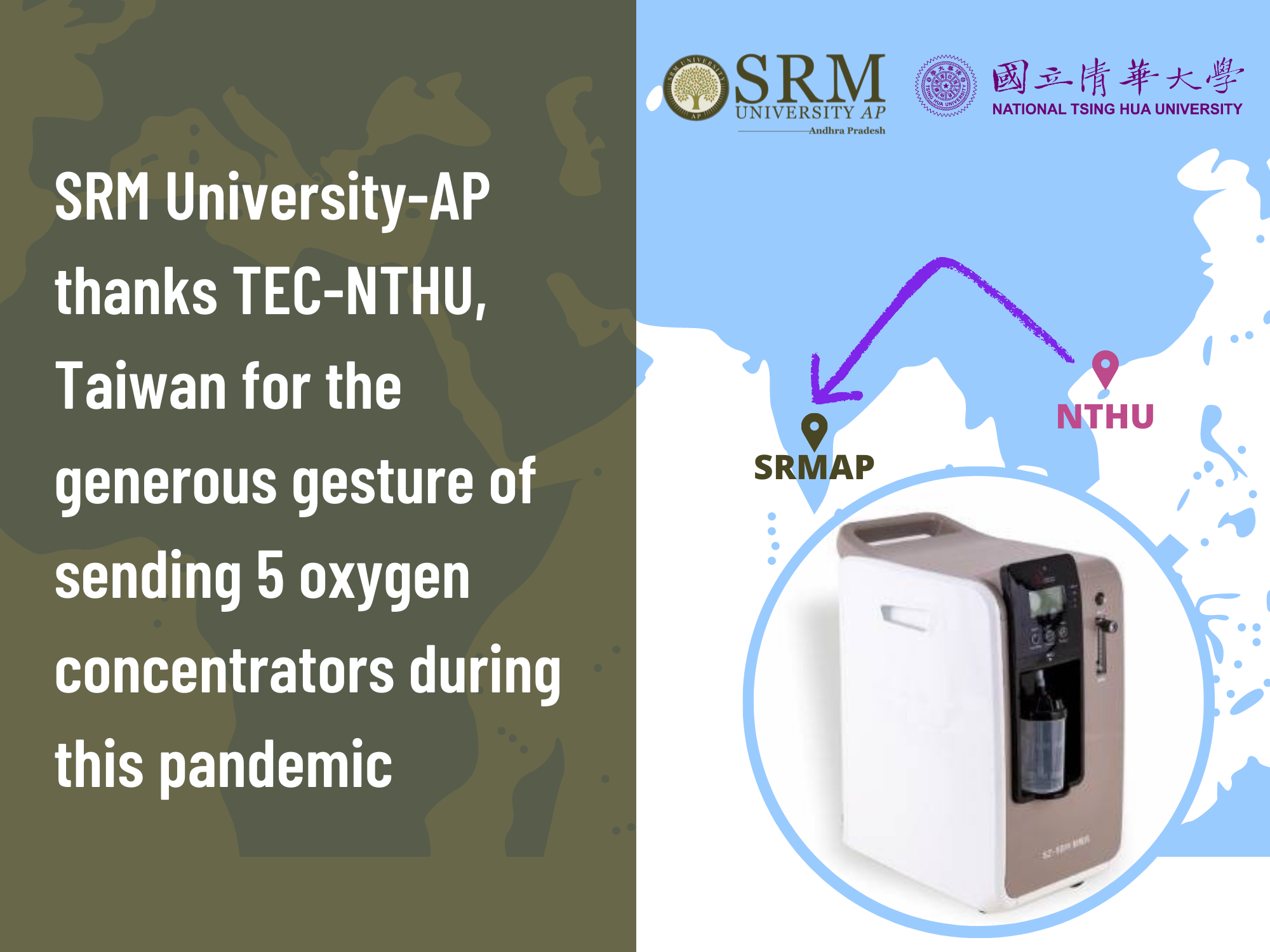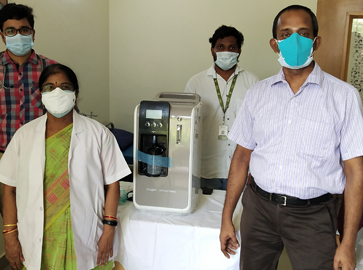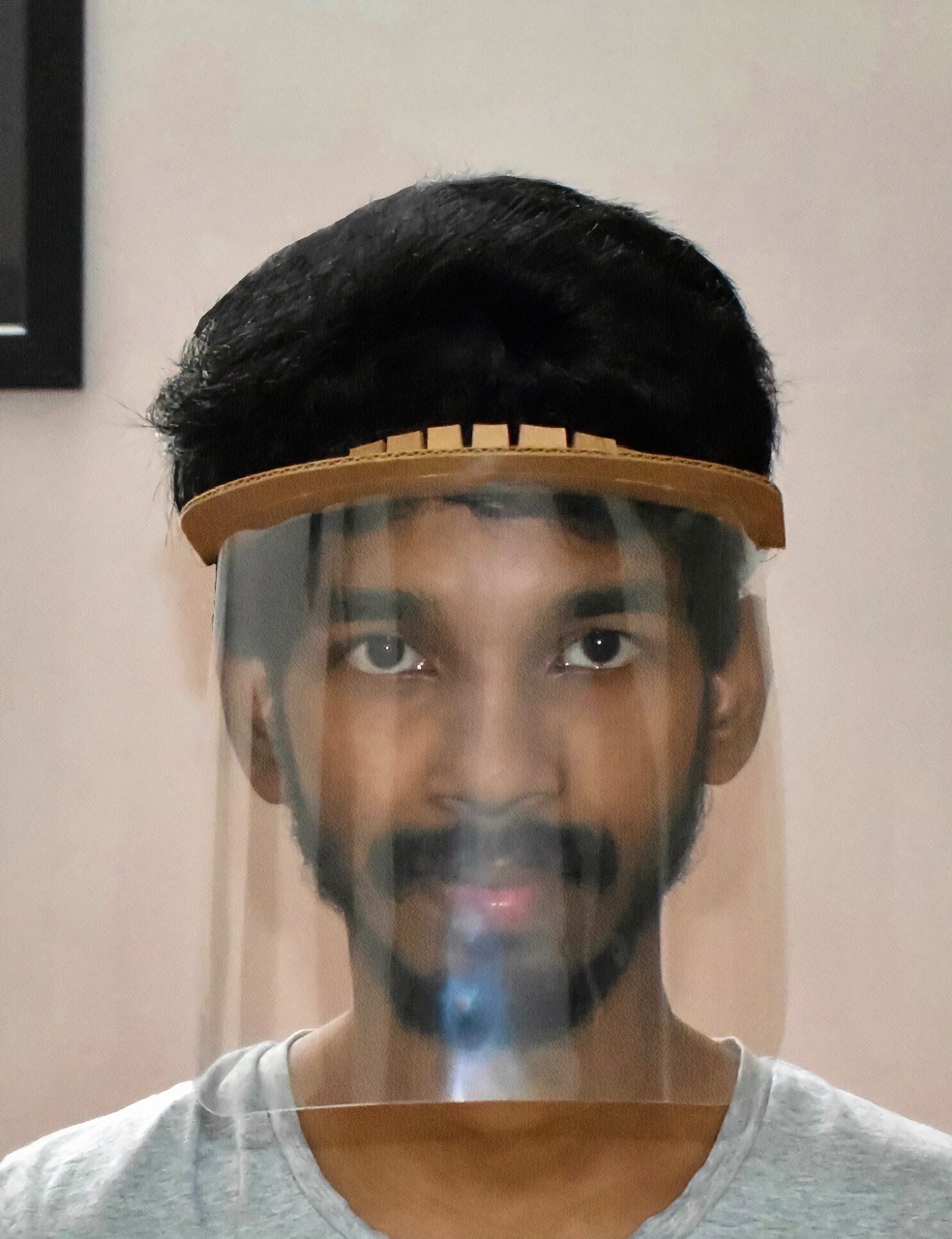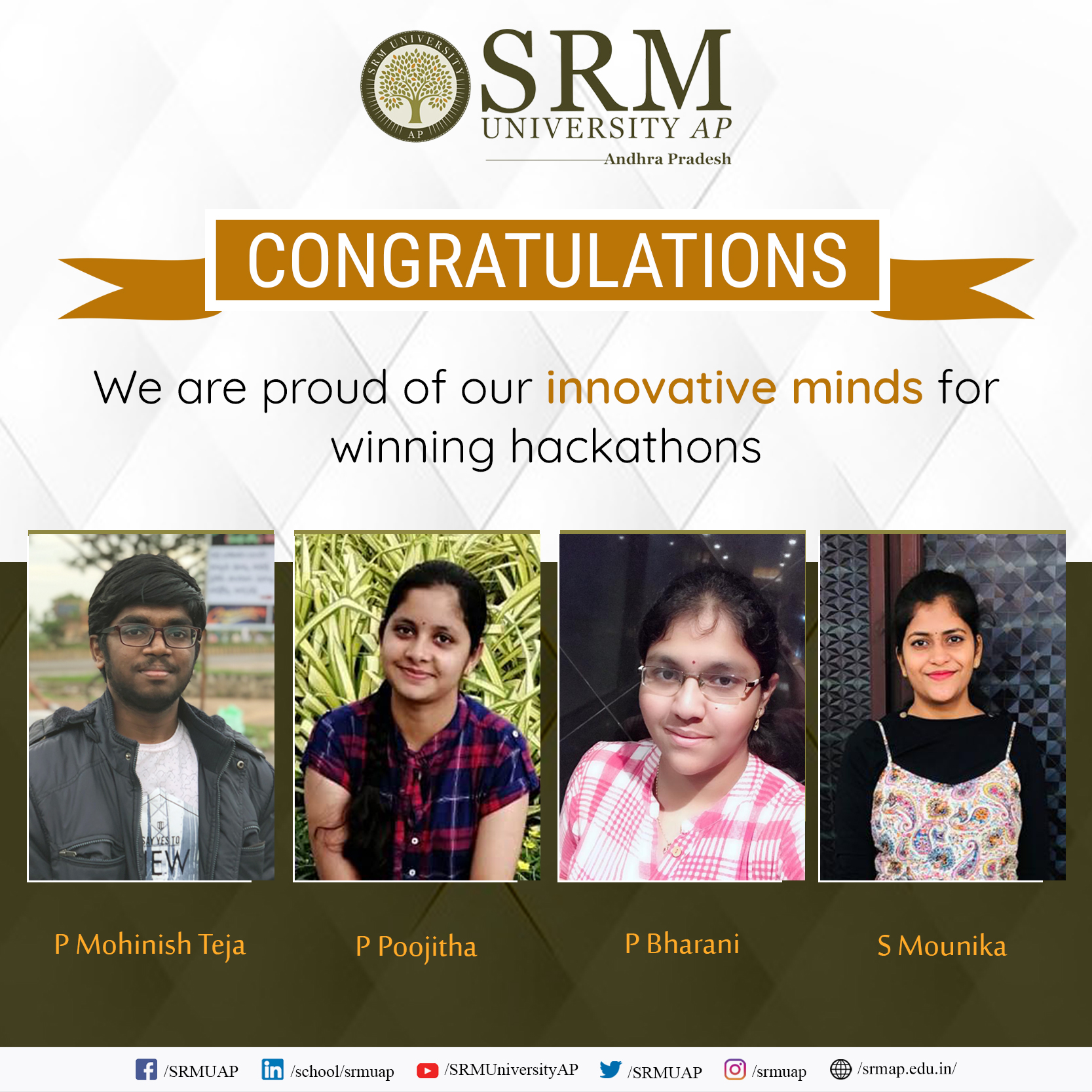Dr Satya Pramod Jammy receives a grant to research missiles and space vehicles
 Dr Satya Pramod Jammy, Associate Professor, Department of Mechanical Engineering, SRM University-AP, Andhra Pradesh, has received a total outlay of Rs. 38,61, 264/- from Department of Science and Technology (DST) Science and Engineering Research Board, Government of India, to work on the project titled “Wall effects in Shock wave boundary layer interactions”. Using the grant, state-of-the-art HPC computational facilities based on the exciting General Purpose Graphic Processing Units (GPGPU’s) will be set up to perform missiles and space vehicle research at SRM University AP. Understanding the fundamental physics of how these vehicles behave in challenging atmospheres will contribute a lot to the design of current and future space vehicles re-entering from space into earth and mars atmospheres. The project aims to develop methods that can capture high-resolution images (like a DSLR camera) of these flows using minimal computational resources.
Dr Satya Pramod Jammy, Associate Professor, Department of Mechanical Engineering, SRM University-AP, Andhra Pradesh, has received a total outlay of Rs. 38,61, 264/- from Department of Science and Technology (DST) Science and Engineering Research Board, Government of India, to work on the project titled “Wall effects in Shock wave boundary layer interactions”. Using the grant, state-of-the-art HPC computational facilities based on the exciting General Purpose Graphic Processing Units (GPGPU’s) will be set up to perform missiles and space vehicle research at SRM University AP. Understanding the fundamental physics of how these vehicles behave in challenging atmospheres will contribute a lot to the design of current and future space vehicles re-entering from space into earth and mars atmospheres. The project aims to develop methods that can capture high-resolution images (like a DSLR camera) of these flows using minimal computational resources.
Dr Jammy is an expert in multi-scale modelling of turbulent flows at high Mach numbers. He is also the lead developer of OpenSBLI, a free and open-source software (FOSS) distributed to the community for free. Dr Jammy and his group will focus on unravelling the concepts like engine unstart in SCRAMJETS, design of better aerodynamic control surfaces for re-entry.
- Published in Mechanical Engineering NEWS, News, Research News
SRM University-AP receives oxygen concentrators from collaborator TEC-NTHU to fight the COVID-19 pandemic
 As the famous saying goes, “A friend in need is a friend indeed.” Bearing the signature of a true friend, Taiwan Education Centre – National Tsing Hua University (TEC-NTHU) has presented five oxygen concentrators to SRM University-AP, Andhra Pradesh. The powerful and lightweight oxygen concentrators can run around the clock with a maximum flow of 5 litres/minute. The Programme Office for Taiwan Education Center in India handed over the oxygen concentrators to the Medical Centre, SRM University-AP, on May 20, 2021.
As the famous saying goes, “A friend in need is a friend indeed.” Bearing the signature of a true friend, Taiwan Education Centre – National Tsing Hua University (TEC-NTHU) has presented five oxygen concentrators to SRM University-AP, Andhra Pradesh. The powerful and lightweight oxygen concentrators can run around the clock with a maximum flow of 5 litres/minute. The Programme Office for Taiwan Education Center in India handed over the oxygen concentrators to the Medical Centre, SRM University-AP, on May 20, 2021.
SRM University-AP has recently signed a Memorandum of Understanding with Taiwan Education Centre – National Tsing Hua University (TEC-NTHU) for bilateral exchange of knowledge and wisdom. TEC-NTHU is in the process of opening a TEC-SRMAP centre on the university campus to provide certificate courses on the Chinese (Mandarin) language. The centre will also assist the students towards the academic opportunities and scholarships available in Taiwan. An instructor in this regard has already been recruited by SRM University-AP.
 A well-populated country like India has been hit hard by the repeated waves of the COVID-19 pandemic. The crisis for oxygen and other medical supplies are very much evident throughout the nation. SRM University-AP, Andhra Pradesh, sincerely expresses gratitude towards Taiwan Education Centre – National Tsing Hua University (NTHU) for their kind gesture in the trying time.
A well-populated country like India has been hit hard by the repeated waves of the COVID-19 pandemic. The crisis for oxygen and other medical supplies are very much evident throughout the nation. SRM University-AP, Andhra Pradesh, sincerely expresses gratitude towards Taiwan Education Centre – National Tsing Hua University (NTHU) for their kind gesture in the trying time.
Dr V S Rao, the Vice-chancellor of SRM University – AP, thanked Prof. Wei-Chung Wang, Program Office Director for TEC-NTHU for their very generous support at this juncture. The oxygen concentrators are currently used by the faculty members and their families who require oxygen support due to COVID19 infection.
- Published in Collaborations, News
P Mohan Aditya granted copyright for biodegradable Face Shield design
 When the Covid-19 outbreak crippled the world, P Mohan Aditya, a 3rd-year Mechanical Engineering student from SRM University-AP, made an initiative of developing the highly useful face shield made from bio-degradable substances. He named it “Facial Shield 2.0”, as it was an improved version of the ordinary face shields. The innovative features added to it helped him to earn the copyright to his credit. On May 16, 2020, Aditya filed an application on the face shield design under the IPR (Intellectual Property Rights) with Indian Patent Office, located in Kolkata, India. In 2021, a copyright was granted for the” Face Shield for Humans” with a Design Application Number of 329364 – 001.
When the Covid-19 outbreak crippled the world, P Mohan Aditya, a 3rd-year Mechanical Engineering student from SRM University-AP, made an initiative of developing the highly useful face shield made from bio-degradable substances. He named it “Facial Shield 2.0”, as it was an improved version of the ordinary face shields. The innovative features added to it helped him to earn the copyright to his credit. On May 16, 2020, Aditya filed an application on the face shield design under the IPR (Intellectual Property Rights) with Indian Patent Office, located in Kolkata, India. In 2021, a copyright was granted for the” Face Shield for Humans” with a Design Application Number of 329364 – 001.
The face shield 2.0 serves as the outer defence to the mucous membranes (nose, eyes, and mouth) and comes with a transparent visor made of a thin layer of 175-micron reusable plastic and a highly durable headband made of 3-ply corrugated cardboard. The cardboard’s bursting strength is 16kg/sq.cm, which is quite durable yet lightweight. Due to the use of biodegradable materials, the price of a face shield is at an affordable cost of INR 15. The face shield 2.0, made with firm elastic, is adjustable and suitable for all head sizes for comfortable wear without hurting the head.
Shri Adimulapu Suresh, Hon’ble Minister of Education, Andhra Pradesh and Sri Nandigama Suresh, Hon’ble MP, appreciated the student’s efforts in the Secretariat’s premises. Aditya received high accolades from the guests present on his first successful invention. They also distributed face shields among state police officers, paramedics and other frontline workers deployed in the containment areas.
In a conversation with P Mohan Aditya, he says, “With an increasing environmental degradation, we should move to the eco-friendly alternatives to develop products/services. Therefore, I thought to develop face shields from reusable plastic and cardboard, which are easily degradable. After discovering a shortage in the supply of Personal Protective Equipment (PPE) globally, the idea struck my mind. Immediately I started researching on developing a piece of standard equipment to combat the Covid-19 pandemic. I am thankful to Mr Ravi, the attorney at SRM-AP, who supported me throughout the tough times by answering all doubts amidst challenging circumstances.”
 Aditya’s invention turned out to be a successful project both for the University and the public. The leadership team of SRM University-AP – Dr P Sathyanarayanan, President, Prof V S Rao, Vice-Chancellor, and Prof D Narayana Rao, Pro-Vice-Chancellor expressed their happiness on Aditya’s success by congratulating him on developing the face shield and making use of eco-friendly technology.
Aditya’s invention turned out to be a successful project both for the University and the public. The leadership team of SRM University-AP – Dr P Sathyanarayanan, President, Prof V S Rao, Vice-Chancellor, and Prof D Narayana Rao, Pro-Vice-Chancellor expressed their happiness on Aditya’s success by congratulating him on developing the face shield and making use of eco-friendly technology.
Using the CAD software, Aditya designed the transparent visor of the face shield and fabricated the remaining headband with the CNC machine. The CAD model was used as the input to the CNC machine, Following the design, the CNC machine analysed and cut the cardboard and transparent sheet accordingly.
P Mohan Aditya’s another innovative design on “building block for bed” was applied for a copyright on 09-08-2020. The building block for bed is again an innovative work of making beds using reusable materials for COVID 19 patients. He and his team also successfully created an electric bicycle using a 24V 250Watt DC motor powered by a 12V and 12Ah battery as a team assignment. Aditya desires to be a successful engineer and creator of such inventions for the betterment of society.
- Published in Mechanical Engineering NEWS, News, Research News, Students Achievements
Grad students developed society friendly apps, won Hackathons
 The SRM University-AP student, P Mohinish Teja from the Department of Computer Science and Engineering, brings laurel to the university by bagging the first prize at the Hackathon organised this year on April 16-18th by the Cal Hacks Team, University of California, Berkeley. More than 450 participants signed up for the world’s popular code-fest. Amongst these global participants, Mohinish won the title of “Best Hack” and a prize of $1000 worth of file coins from the sponsoring partner, Protocol Labs.
The SRM University-AP student, P Mohinish Teja from the Department of Computer Science and Engineering, brings laurel to the university by bagging the first prize at the Hackathon organised this year on April 16-18th by the Cal Hacks Team, University of California, Berkeley. More than 450 participants signed up for the world’s popular code-fest. Amongst these global participants, Mohinish won the title of “Best Hack” and a prize of $1000 worth of file coins from the sponsoring partner, Protocol Labs.
The idea of the application “Eco gift” is inspired by the Undergraduate Research Oriented Project under the guidance of Dr Ashok Kumar Pradhan, Assistant Professor-CSE and Mr Santosh Bhaskara, doctoral research scholar. Mohinish developed a Waste Management Decentralised Application called “Eco gift” using Blockchain Technology that rewards the users who categorically dump the waste. This application credits crypto tokens into the app users’ wallet. Even though it will not be the traditional currency, it can be used during registration, paying application fees, and payments at the government portals. The reward value increases with time, and the individual receives the token immediately after installing the application.
Mohinish led the team members P Poojitha, P Bharani, and S Mounika into another segment of Hackathon, Civhacks, organised by the Association of Students at the University of California, Berkeley, from April 23-25th where they bagged the “Best Civhacks” title.
The team developed a website application called “Anonymous Hawk” that displays the reported news by keeping the identity of the reporter anonymous for security reasons. The reporters facing life threats for reporting on the sensitive issue can sign up on the application. One can register simply by signing the transaction into the Blockchain. The data uploaded is stored in the Ethereum network and cannot be trifled by humans or software. The free flow of the information can take place by using the application without the fear of being targeted by any influential agents.
“Anonymous Hawk” brought each group member a prize of $500 file coins. The team was granted an opportunity to work further on the project by the sponsoring team, Protocol Labs. Mohinish expressed, “We are at the initial stage of the development of the high-end Decentralised App. In the next stage, we shall work on controlling the spamming of the information using the data and web-mining algorithms.”
- Published in CSE NEWS, News, Students Achievements

